 Summary: When used properly, dashboards give your executives real-time insight into your organization’s key metrics. However, some dashboards do more harm than good–wasting your valuable time and hindering your decision-making process. Learn why, and which type of dashboard lets you avoid this problem.
Summary: When used properly, dashboards give your executives real-time insight into your organization’s key metrics. However, some dashboards do more harm than good–wasting your valuable time and hindering your decision-making process. Learn why, and which type of dashboard lets you avoid this problem.
An executive dashboard provides decision makers with a visual representation of their company’s Key Performance Indicators (KPIs). They display a live overview of business operations and help leaders make quick, informed decisions.
How the wrong dashboards waste time
The problem is, dashboards often lack flexibility. They display a pre-determined set of metrics in a pre-set layout.

While this works if your dashboard never need any changes, let me ask you a few questions:
What happens if you need slightly different data in your dashboard than others need?
What happens if you need your dashboard formatted differently?
What happens if the dashboard you receive doesn’t quite meet your expectations?
Or, what if you need an additional metric in your dashboard?
For traditional dashboards, this requires the IT department. If you need a new dashboard, or an existing dashboard changed, you go through the IT department.
It means you submit a ticket, describe what you need, and wait. You could wait days, or you could wait weeks. It all depends on how busy your IT department is at the time.
What does this mean for your business? It means you can’t analyze the data you need right away. It means you can’t operate as smoothly as you’d like. It means that your decision-making process suffers.
Wouldn’t you rather have a dashboard that you could change yourself? Wouldn’t you rather customize your dashboard on the fly with the data you need?
Of course!
What’s the answer?
Here’s one way: Try user-defined dashboards. User-defined dashboards let you
– control which data you see in your dashboard,
– control the structure and layout of your dashboards,
– create your own custom dashboards, and
– save and share your dashboards with other users.
To get a better idea how user-defined dashboards work, check out this short video:
In other words, user-defined dashboards give you your own customizable dashboard. The IT department just creates a single dashboard, and lets each individual user customize the layout and data to their liking.
If you’d like to bring user-defined dashboards to your business, let us know. We’d be happy to help!